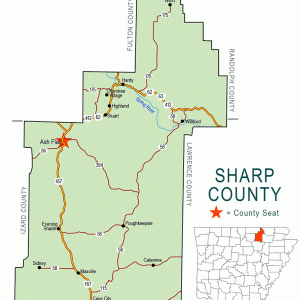calsfoundation@cals.org
Calamine (Sharp County)
Calamine, home to some of the earliest settlers in what is now Sharp County, was the site of the state’s first commercial zinc mining operation. The boomtown experienced periods of rapid growth in the 1850s and 1870s but today consists only of a few homes. The town is most likely named after the pink mineral calamine; however, a local tradition claims that the name originated from a female mine owner named Callie, thus “Callie mine.”
Long before white settlers moved to the area, the Osage used the region for hunting. The first white settlers entered by the early 1830s, many by way of the recently completed military road connecting the area to the Black River. A small settlement began to develop around area springs, which were said to provide upwards of 65,000 gallons of water an hour. Rapid development began with the discovery of zinc in the 1850s. Mining began in 1856, at a time when all zinc used in the United States was being imported. The population immediately began to grow, and overnight a town began to develop. The Independence Mining Company, the first company to begin mining, was incorporated on December 17, 1856. A charcoal plant and a smelter were soon built with a 150-foot-tall brick tower. Within two years, four mines had been opened, and other companies had begun operations with approximately 150 employees. In 1861, the Civil War brought an unexpected closing of the mines. There was speculation that pro-Confederate supporters destroyed the smelter and forced the operations to close due to Northern ownership.
During the war, at least six companies of Confederate recruits came from the Sharp County area, with many of the Calamine men enlisting in units raised by Robert G. Shaver and Joshua Wann. On June 17, 1862, about nine miles northeast of Calamine, Union forces won a victory at the Skirmish at Smithville. Also in 1862, a temporary Union camp was established at the local springs. A more serious concern was the irregular bands of jayhawkers and bushwhackers that moved in and out of the area during the war.
By 1870, mining was renewed, and the town once again came to life. A new smelter and brick tower were constructed, and modern mining equipment was shipped in. People began to arrive, and shops, a hotel, a sawmill, a cotton gin, and a brickyard were soon open for business. Zinc was taken from the mines and hauled to the Black River for shipment, with goods brought back to the town on the same wagons. In 1871, a post office was established; the post office closed in 1967. Much of the zinc was being exported for use by military forces in the Franco-Prussian War. When the war ended in May 1871, demand for zinc declined, and almost as suddenly as the mining had resumed less than a year before, it ceased.
The mine’s closing did not immediately result in the decline of the town. Instead, Calamine became something of a commercial center for the area. By 1880, the population of the township of which Calamine was a part totaled 1,357. Part of the interest in the town was maintained by religious groups. A Methodist revival, bringing in pilgrims some claimed numbered in the thousands, was held at the local springs beginning in 1892. Normally held in early August, the revival was held on Sundays over a two-week period. Some visitors stayed for the entire period. By 1912, the Church of the Nazarene took charge of the recurring revival, which was held until the early 1980s. Though schools existed in the area, no sessions were conducted in the town until 1906. In 1948, the school was consolidated with Poughkeepsie (Sharp County), Strawberry (Lawrence County), and Cave City (Sharp County).
With improvements in transportation, rural commercial centers such as Calamine began to lose much of their importance by the mid-twentieth century. Over time, businesses closed, and people moved to nearby larger towns. By 2010, all that remained of the once prosperous town were a few homes.
For additional information:
A History of One-Room Schoolhouses of Sharp County: Country School Memories. Mount Vernon, IN: Windmill Publications, 1993.
Thompson, Frank. “A History of Calamine.” Sharp County Journal 2 (January 1982): 1–46.
Wallace, Michelle. “Calamine Founded with Civil War Era Zinc Mining.” Arkansas-Democrat Gazette. Three Rivers Edition. October 2, 2004, p. 4S.
Mike Polston
CALS Encyclopedia of Arkansas
 Calamine
Calamine  Calamine Store
Calamine Store  Sharp County Map
Sharp County Map 




I grew up in Calamine in the 1970s-90s. The post office didn’t close until the mid-1980s. It was located in the general store run by Glen and Mildred (Sullivan) Huddleston. Population of Calamine at that time was roughly 25 people and several farm animals and pets.
Memories of this area are set to me. When I was a child, we would travel to Calamine to see my grandparents. That was in the 1940s. The original Calamine is not the picture shown. Calamine was located back toward Cave City. I remember the grocery stores, and one store had a post office inside. Disco Sullivan owned the store with post office, and the Richardsons owned the store on the main drag. I am one of many grandchildren of Joseph Emit and Nannies Clem.